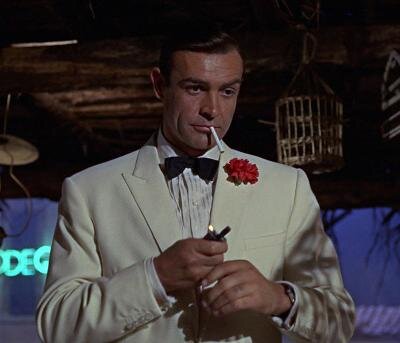The White Dinner jacket
Houstoun G. Waring
Sean Connery in Goldfinger
“Once you embrace the white dinner jacket, wear it with confidence and the knowledge that you are in the company of many well-dressed gentlemen.”
As introduced by Esquire
Few articles of clothing elicit such passionate reactions as the white dinner jacket. Love it or hate it, the garment has long been a staple of the gentleman’s summer wardrobe and remains a popular choice for spring and summer weddings.
In the days before air conditioning, the dark wool fabrics used in the construction of evening wear did not lend themselves well to warm climates. Gentlemen summmering in Palm Beach or vacationing in Nassau or Havana required a substitute for their standard evening attire that was appropriate for use in the tropics. The white dinner jacket emerged in the 1930s as a more bearable alternative, and it immediately gained acceptance among the leisure class. Hollywood immortalized the garment with such iconic examples as Humphrey Bogart’s double-breasted coat in Casablanca and Sir Sean Connery’s portrayal of James Bond in Goldfinger.
The white dinner jacket is worn in the same way as a standard tuxedo, with all of the standard elements: black bow tie, black cummerbund, black evening trousers, black socks, and black formal pumps or oxford shoes. The only differences are in the coat’s color and fabric, which may include tropical wool, linen, or dupioni silk. Although known as a “white” dinner jacket, the desirable color is cream or ivory rather than stark white. Pure white coats have generally been reserved for military mess dress or the uniforms of waiters and bartenders.
The white dinner jacket is most often cut in a single-button, single-breasted pattern with shawl lapels. Peak lapels are a popular alternative. The notch lapel should be avoided as it resembles a simple sport coat. While tuxedo lapels are trimmed in either silk satin or grosgrain, the white dinner jacket is traditionally “self-facing,” or devoid of any silk embellishment. This is in keeping with the relaxed formality of the environment where worn.
The age-old adage prohibits one from “wearing white after Labor Day,” and there are those who take this dictum quite seriously. Easter in the Deep South marks the day when one may again “wear white,” while in the North this occasion is delayed until Memorial Day. While these dates may seem arbitrary, they are rooted in the natural principle of dressing as the weather requires. For practical reasons, one wouldn’t wear a cashmere topcoat in Texas in July, while he wouldn’t wear Bermuda shorts in New York in January.
While we generally recommend restricting the white dinner jacket’s use to the summer months, as with any “rule” there are exceptions. Many themed occasions such as “Havana Nights,” “James Bond,” “Casablanca,” or “An Evening in Monte Carlo” lend themselves well to the white dinner jacket, and they afford the coat’s owner an additional opportunity to justify its purchase. More important than the date on the calendar is the nature of the event.
In determining whether the white dinner jacket is appropriate for a given event, we suggest asking, “Would I be embarrassed if I am the only one not in a black tuxedo, or might I offend my host by stealing attention?” For any of the aforementioned themed occasions, the white dinner jacket is probably appropriate and will garner positive attention. As a guest at a black tie wedding in November, it likely is not.
Once you embrace the white dinner jacket, wear it with confidence and the knowledge that you are in the company of many well-dressed gentlemen.

